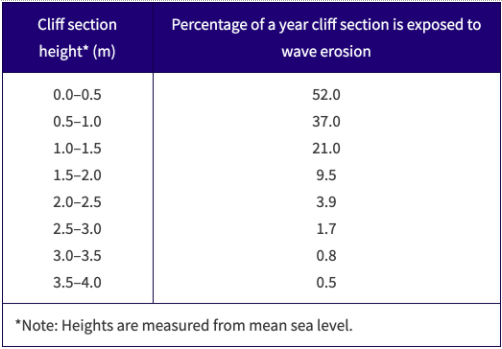The correct answer is (D).
Getting to the Answer: The question asks about a cliff section with a height of 4.0?4.5 m above the zero baseline, which is not listed in the Table. Thus, you will need to extrapolate the data. To predict the percentage of a year that the cliff would be exposed to wave erosion, determine the relationship between cliff section height and percentage exposed to wave erosion in the Table. The Table shows that as the interval for cliff section height increases, the percentage decreases. At a cliff section height of 3.5?4.0 m, the percentage is 0.5. Thus, the percentage for a cliff section with a greater height of 4.0?4.5 m will be less than 0.5.
(A) Incorrect: the percentage of a year a cliff section is exposed to wave erosion is inversely proportional to the cliff height; 10% is greater, not less, than 0.5%, the percentage for a height of 3.5?4.0 m
(B) Incorrect: the percentage of a year a cliff section is exposed to wave erosion is inversely proportional to the cliff height; 2% is greater, not less, than 0.5%, the percentage for a height of 3.5?4.0 m
(C) Incorrect: the percentage of a year a cliff section is exposed to wave erosion is inversely proportional to the cliff height; 0.8% is greater, not less, than 0.5%, the percentage for a height of 3.5?4.0 m
(D) Correct: the percentage of a year a cliff section is exposed to wave erosion is inversely proportional to the cliff height; 0.3% is less than 0.5%, the percentage for a height of 3.5?4.0 m
